Sheldon Brown's
Bicycle Glossary Sa - So

|
![]()
Sachs also made multi-speed internal-gear hubs in 3-, 5-, 7- and 12-speed versions. Their "3 x 7" hub was a hybrid system, a 3-speed internal hub that took a 7-sprocket cassette, providing 21 speeds with only one chainwheel.
Sachs formerly also made kick-back hubs and a "2 x 6" hybrid hub, the "Orbit". The one clear area of domination for Sachs was its chains, which were generally acknowledged to be the finest available.
Sachs was the major European competitor to Shimano for the general bicycle parts market. Their parts in general were quite good, and stand up well in comparison with Shimano equivalents, although exchange rate problems sometimes make them less affordable. The bicycle division was sold to the SRAM Corporation, in November 1997. Most of the products formerly called "Sachs" are now called "SRAM." Up-to-date information is on the SRAM site.
Leather saddles are particularly well suited to long-distance tourists, and have their greatest advantage in hot weather, because they are porous and able to breathe, unlike plastic saddles which have closed-cell foam (also known as "gel") as a cushion. There is a more extensive article on Leather Saddles on this site.
Most cyclists have never experienced the comfort of a well broken-in leather saddle, because most modern bicycles come with plastic saddles which require no break in or other maintenance. Plastic saddles are also lighter and cheaper than leather ones. There is a general, major article on saddles on this site, covering: Adjustment, Angle, Front/Back, Gel, Hard or Soft?, Height, Impotency, Leather, Pads, Plastic, Posting, Prostate, Recumbents, Springs, Seatposts, Suspension, Wide or Narrow?
The two breakthroughs that allowed the safety bicycle to obsolete the high wheeler were Dunlop's pneumatic tire and chain drive.
Some people believe that the term derives from the verb "sag", others maintain that it is an acronym for "Support And Gear."
![]()
![]()
There is a third type of valve, very rarely seen in the U.S., which has a bottom similar to a Schrader and necks down to about the size of a Presta. This is a Woods valve, formerly popular in the British Isles and Asia.
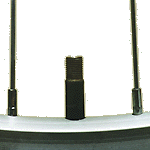 |
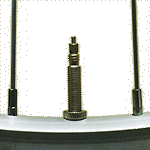 |
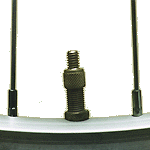 |
|---|---|---|
| Schrader valve | Presta valve | Woods valve |
The external threaded part of a Schrader valve is 7.7 mm (.302") x 32 T.P.I.
This term probably originated as a comical mispronunciation of "swag."
If the threads do not extend full length, technically it is a "bolt" but only pedants insist on this distinction.

Older seatposts, and those on cheap bicycles, are basically pieces of pipe, perhaps with a different diameter (usually 7/8" / 22.2 mm) at the top end. A separate clamp attaches the saddle to this type of seatpost.
Modern, high-quality seatposts have the saddle clamp mechanism built into the top of the post. This type is also commonly referred to as "microadjusting" because it permits a finer degree of adjustment of the saddle angle.
Seat posts come in a wide range of diameters, from 21.15 mm to 31.8 mm. Low end department-store bicycles are typically 21.15 mm (13/16"). Most bicycles with one-piece cranks, including most BMX machines use this size. Bicycles with standard-size (1 1/8" / 28.6 mm o.d.) seat tubes usually have seatposts between 25.4 (1") and 27.2 (1.07") in diameter. Seatposts typically come in sizes with even-numbered tenths of millimeters (26.0, 26.2, 26.4...).
For standard-sized seat tubes, the larger the seat post the thinner the tube. Thus, a larger seatpost size is often an indicator of a lighter, fancier frame.
I have a Database of Seat Post Sizes for various bicycles available on this site.
More information on seatposts is available in my article on Saddles.
The adaptor consists of a grooved brass plate which fits between the upper and lower rails, so that the vertical clamp bolt doesn't distort them by squeezing them together. This accessory includes a longer than normal bolt, and is primarily used for mounting wider Brooks leather saddles, such as the B-72 and B-66.
The spline pattern was chosen to permit the spindle to fit through a Front-Freewheel bearing set, because a standard-sized square-tapered bottom bracket spindle would not fit.
This design turned out to be rather unreliable, due to the small diameter of the splines, and Shimano abandoned the system. Shimano did continue to supply spare parts for many years thereafter, but these are no longer available.
Self-energizing brakes are quite controversial, because they can have a non-linear response, which may lead to wheel lock-up.
There are several Italian saddle makers whose corporate name begins with "Selle", including Selle Italia, Selle Royal, Selle San Marco and others. Sometimes people try to shorten these names and say "Selle saddle", which actually makes no sense.
![]()
![]()
Rings with set screws are used to hold some cartridge bearing hubs and bottom bracket assemblies together.
Some tandem eccentric bottom brackets use set screws to hold the eccentric in position. A very few (mostly antique) bicycles also use set screws to secure the seatpost in the frame.
Shaft drive was briefly popular around 1900, and occasional attempts are made to revive the design. Unfortunately, shaft drive turns out to have more problems than advantages.
A shaft drive requires heavier frame construction around the bevel gears to maintain their precise alignment under load. The drive system is heavier and less efficient than a good chain drive.
For reasons of clearance, the bevel gears of a shaft drive bicycle must be considerably smaller than the typical sprockets used with a chain drive. The smaller size of the gears causes an increase in the stresses on the whole support system for the shaft. This problem is exacerbated because the stresses from the shaft drive are not perpendicular the triangulated structure of a bicycle frame, and so are not well-resisted. .
Most of the advantages touted by proponents of shaft drive are only advantages compared with open-chain, derailer gear systems. Many proponents of shaft drive use specious (if not dishonest) arguments "comparing" shaft drive systems with derailer gear systems. Any such comparisons are meaningless, it's like comparing apples and locomotives.
A valid comparison of shaft vs. chain drives can only be made if both bikes use the same type of gearing, whether single-speed or with an internal gear system.
These same advantages can be obtained with chain drive using a fully-enclosing chain case, as with old English roadsters and many current Dutch bikes.
Shaft drive proponents also often compare sealed, enclosed shaft drive systems with open, exposed chain drive systems. This is also a misleading comparison. All of the advantages claimed for shaft drive can be realized by the use of a chain case.
This product was made of black plastic, with a peel-and-stick backing and a zip tie to hold it to the chainstay.
| Conventional fender nut |
Sheldon fender nut |
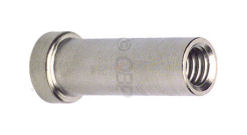 |
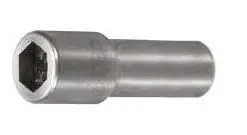 |
Because of the increased popularity of twist-grip type controls, which are not levers, I have reluctantly come to accept the common usage of the term "shifter" to refer to the hand control.
![]()
![]()
Shimano achieved this position because it has the most successful research and development program in the industry. Shimano pioneered many key technologies:
All bicycles are subject to shimmy under the right (wrong) circumstances, but it is more pronounced in some than in others.
Simplex also made a "Rétrofriction " down-tube shift lever that is considered by many to be the finest pre-index shift lever ever.
See also my page on French bicycles.
See my Article on Singlespeed Mountain Bikes
(As far as I know, I was the first to deliberately remove the multiple-speed gearing from a mountain bike to make it simpler, lighter and more reliable...if I do say so myself!)
![]()
![]()
The rim diameter is about the same as standard tubulars , though few tubulars are as wide as the typical single tube. Reportedly, however, tubulars can be mounted on singletube rims. I haven't actually tried it, can't guarantee that it will work.
Single-tube tires were forced on the U.S. market by a monopoly that excluded the better European clincher tires. Because single-tube tires were so difficult to repair, they drastically reduced the appeal of bicycling in the USA -- as is clear from a comparison of levels of bicycle use in the USA and Canada, where good European tires were available.
Bicycle tires have such a small contact patch and run at such high pressures that hydroplaning is an imaginary problem, even with completely slick tires.
Fixed-gear riders who make a habit of doing "skip stops" wear the rear tire out considerably faster than those who use a brake. This problem is exacerbated by certain gear ratios, because they may tend to repeatedly skid on the same section of the tire.
Riders who plan to do a lot of skip stops should consider the ratio when selecting their chainring and rear sprocket. The mathematics of this is actually fairly simple:
48/12 simplifies to 4/1, so there will be only 1 skid patch
45/15 simplifies to 3/1 so there will only be 1 skid patch, or 2 if you are an ambidextrous skidder.
42/15 simplifies to 14/5, so there will be 5 skid patches.
44/16 simplifies to 11/4, so there will be 4 skid patches, or 8 if you are an ambidextrous skidder.
43/15 can't be further simplified, so there will be 15 skid patches, or 30 if you are an ambidextrous skidder.
Explanation: let's look at 45/15, or 3/1. The rear wheel turns exactly 3 times for each turn of the cranks -- so, if the same foot is forward, the same place on the rear tire is always down. 1/2 turn of the cranks places the other foot forward, and turns the rear wheel 1 1/2 times. Then, the opposite place on the tire is down. Similarly for higher numbers, if the numerator of the reduced fraction is even, skid patches will be in the same places with either crank forward, but if the numerator is odd, the number of skid patches with each crank forward will be odd, and skid patches with one crank forward will interleave with those with the other crank forward. John Allen's Excel spreadsheet calculates the number of skid patches for any sprocket combination.
A rear brake also leaves skid patches. The front wheel does not skid in normal braking. A front brake also can stop the bicycle much shorter, but requires care in use to avoid pitching the rider forward: see my article on braking and turning.

An 8-tooth sprocket for 1" pitch "skip link" chain (left) is equivalent to a 16 for standard 1/2" chain.
You have to really want to do it, you can't be tentative! It's easier when you're going faster.
The lower your gear , the more effectively you can "brake" by resisting with your legs.
Despite what some folks will tell you, you can not stop nearly as short this way as you can by using a good front brake.
See my article on Braking and Turning for a detailed explanation of this.
See the entry for skid patch in this glossary for how to choose sprockets to increase wear life of the rear tire if you use skip stops.
Slick tires are smooth and silent-running, and have excellent traction. They have the lowest rolling resistance of all tire styles. Many people reject them because they look slippery, but in practice, they are not. Tread patterns on road tires are purely cosmetic, and have no practical value on hard, paved surfaces.
![]()
![]()
![]()
Last Updated: by John Allen